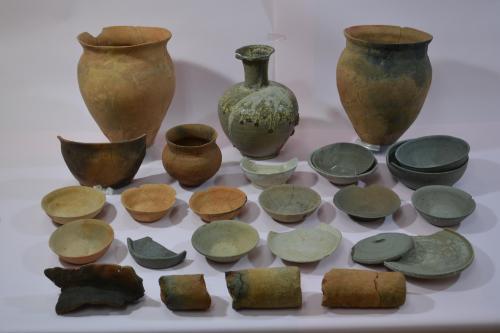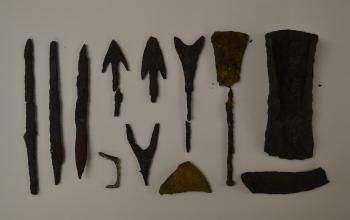Artifacts Excavated from the Inagi Shitate Site

Tateidai Ruins of Inagi City
On the plateau spreading to the southeast of Momura's Tate Shrine, there was the Inagi City Tate Daiseki site. Excavation surveys were conducted from 1991 to 1993, revealing that it is a site primarily from the Jomon period and the Nara and Heian periods. The discovered remains include five pit dwellings from the Jomon period, 310 hunting pitfall pits, 78 pit dwellings from the Nara and Heian periods, 41 post-built structures, and five pit structures for pottery firing. Particularly valuable remains are the dwelling sites and post-built structures from the Nara and Heian periods, which were found to have been continuously occupied from the 8th to the 11th century.
A large number of artifacts, including pottery, stone tools, and iron tools, were excavated from these remains, and 123 particularly important artifacts have been designated as tangible cultural properties of Inagi City.
Jomon Period Materials
The Jomon period artifacts consist of early and middle period pottery, excavated from the remains of pit dwellings. There is one deep bowl-shaped pottery from the early Jomon period, two deep bowl-shaped pottery from the middle period, and one pedestal from the middle period. One piece of early pottery and one piece of middle pottery are believed to have been used for cooking. Additionally, the remaining piece of middle pottery was used as a hearth within the dwelling. The pedestal is 9.7 centimeters tall and 15 centimeters in diameter, used as a stand for placing items, but it is a very rare artifact.
Materials from the Nara and Heian Periods
A total of 119 items from the Nara and Heian periods include 67 earthenware and Sue ware, 6 green glazed pottery and ash glazed pottery, 34 iron tools, and 12 other items.
Haji pottery and Sue pottery
Haji ware is a type of earthenware that inherits the tradition of Yayoi pottery, characterized by its brown color and low-temperature firing. The collection includes 23 items such as long cylindrical jars, bowl-shaped pottery, steamer, pedestal jars, bowl-shaped pottery, and feather pots. Sue ware, on the other hand, is gray pottery made using techniques that were introduced from the Korean Peninsula, shaped on a potter's wheel, and fired at high temperatures in a climbing kiln. The collection consists of 44 items, including bowl-shaped pottery, dishes with foot rings, bowl-shaped pottery, and lids. Both Haji ware and Sue ware can be considered tools that were commonly used in daily life for cooking and dining.
Ash Glazed Pottery and Green Glazed Pottery
Ash-glazed pottery is pottery that has been coated with a glaze made from plant ash, such as straw, and is of slightly higher quality than everyday tableware. Green-glazed pottery is pottery that uses a glaze containing lead, resulting in a yellow-green color. Unlike everyday tools, these were of high quality and were used for ceremonial purposes. Both types of pottery are rare finds and are valuable materials. As materials, there are a total of six items, including a bowl of green-glazed pottery, a bowl of ash-glazed pottery, a plate with a foot, and a long-necked bottle.
Iron Tools
During the Nara and Heian periods, iron tools became widespread as weapons, farming implements, and everyday tools. Many iron tools used at that time were discovered in the remains of pit dwellings. Examples include iron arrowheads, iron sickles, iron axes, iron knives, iron chisels, nails, and iron spinning wheels.
Other Materials
There are sharpening stones for iron tools, stone spindle whorls, and clay weights used as fishing gear.

Please let us know your feedback on how to make our website better.
Inquiries about this page
Inagi City Local History Room
1-9-1 Hirao, Inagi City, Tokyo 206-0823
Phone number: 042-331-0660 Fax number: 042-331-0660
Contact the Lifelong Learning Division, Department of Education, Inagi City

















